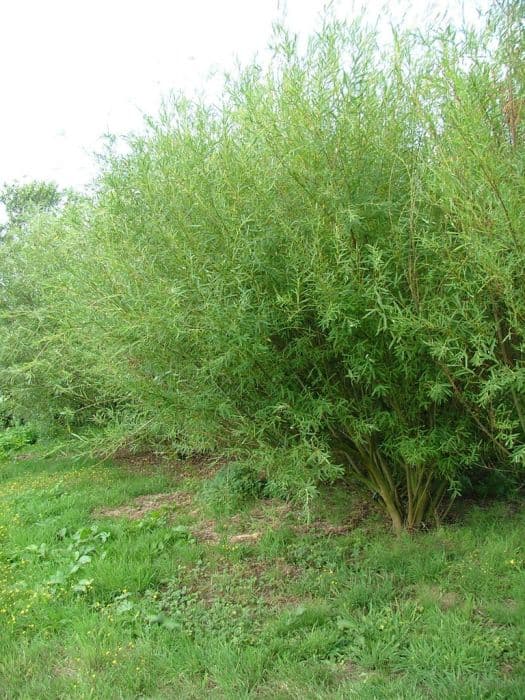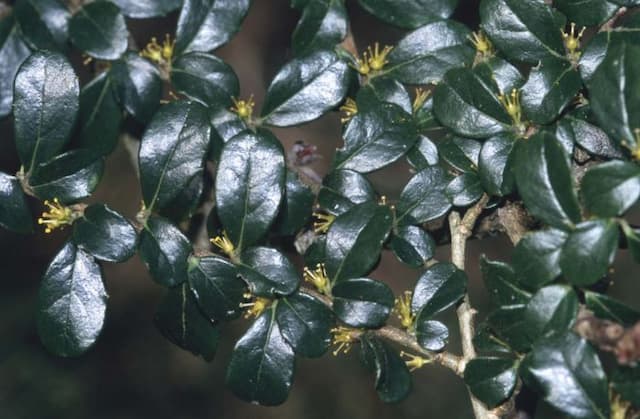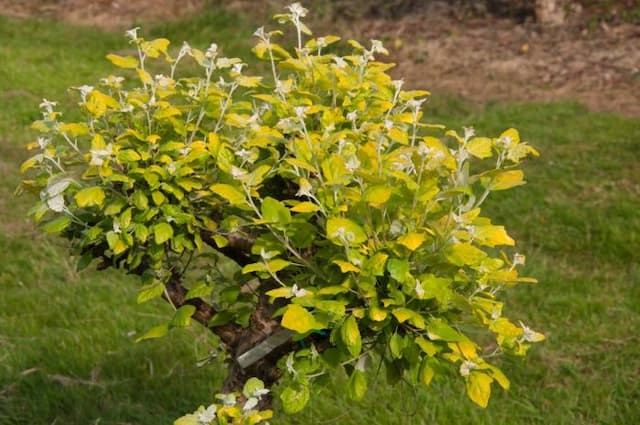Korean Willow Salix koriyanagi

ABOUT
Salix koriyanagi, commonly known as Korean Willow, is a plant with a visually appealing appearance. It is characterized by its graceful, pendulous branches that create a cascading effect, lending a soft texture to the landscape. The plant bears narrow, lance-shaped leaves that are usually bright green on the top, with a slightly paler tone beneath. These leaves can produce a shimmering effect when stirred by the breeze, adding to the Korean Willow's charm. In spring, the Korean Willow is particularly striking as it produces catkins, which are fluffy, elongated clusters of flowers that contribute to its decorative look. These catkins often arrive before the leaves fully expand, and can give the plant a fuzzy appearance from a distance. The color of the catkins may vary, but they generally have a soft, yellowish or silver hue that contrasts nicely with the emerging green leaves. As the seasons change, the foliage of the Korean Willow may change color, taking on golden or yellow tints before falling off as winter approaches, displaying yet another aspect of its visual appeal. The bark of the Korean Willow is typically smooth with a gray to brown color and may develop interesting textures as the plant matures. Overall, the Korean Willow has an elegant and restful aesthetic, making it a popular choice for gardens, parks, and near water features where its dangling branches can enhance the tranquility of the setting.
About this plant
 Names
NamesFamily
Salicaceae
Synonyms
Korean Willow, Koriyanagi Willow
Common names
Salix koriyanagi.
 Toxicity
ToxicityTo humans
Salix koriyanagi, commonly known as the Korean willow, is not typically recognized for being toxic to humans. Most members of the Salix genus, which includes willows, are not harmful if touched or ingested in small quantities by people. However, willows contain salicin, which is a precursor to aspirin, and large amounts could potentially cause adverse effects similar to aspirin overdose. These effects could include stomach pain, nausea, vomiting, and diarrhea. Overdose might also result in more serious effects such as dizziness, tinnitus, and in extreme cases, breathing difficulties and seizures. Nonetheless, usual contact with or incidental consumption of the Korean willow does not pose a significant risk of toxicity to humans.
To pets
Salix koriyanagi, commonly known as the Korean willow, is not generally toxic to pets. Willows are known to contain salicin, which is a pain-relieving compound that is metabolized into salicylic acid, a compound similar to aspirin. While this can be toxic in high doses, casual ingestion of leaves or bark is unlikely to harm domestic animals such as dogs or cats. If an animal were to consume large amounts of the plant, symptoms like gastrointestinal upset, including vomiting or diarrhea, could potentially occur. However, such incidents are uncommon, and the Korean willow is not considered a high-risk plant for pet poisoning.
 Characteristics
CharacteristicsLife cycle
Perennials
Foliage type
Deciduous
Color of leaves
Green
Flower color
Yellow
Height
6-10 feet (1.8-3 meters)
Spread
4-8 feet (1.2-2.4 meters)
Plant type
Tree
Hardiness zones
5
Native area
Korea
Benefits
 General Benefits
General Benefits- Erosion Control: Salix koriyanagi, commonly known as Korean Willow, has an extensive root system that helps stabilize soil and control erosion.
- Wildlife Habitat: It provides shelter and nesting sites for birds and other wildlife.
- Landscape Ornamentation: With its elegant form and pendulous branches, Korean Willow is often used for decorative purposes in gardens and parks.
- Shade Provider: The tree can offer a good source of shade due to its size and foliage.
- Windbreak: It can act as a windbreak to protect against strong winds, when planted in a row or hedge.
- Riparian Buffer: Korean Willow can be planted along stream banks to create riparian buffers that protect aquatic ecosystems.
- Fast Growth: It has a rapid growth rate, which can be useful for quick establishment of vegetation or for projects requiring fast results.
- Soil Improvement: As it sheds leaves and twigs, it contributes organic matter to the soil, enhancing soil fertility and structure.
- Seasonal Interest: The plant provides visual interest throughout the year with its changing foliage and catkins.
- Flexibility in Landscaping: Korean Willow is adaptable to a range of landscape uses including garden ponds, wet areas, and as a specimen plant.
 Medical Properties
Medical Properties- Anti-inflammatory: Salix koriyanagi contains salicin, which is metabolized into salicylic acid in the body and may help reduce inflammation.
- Analgesic: The salicin present in the plant may also contribute to pain relief, similar to aspirin.
- Antipyretic: Salix koriyanagi may have properties that help reduce fever, again due to the salicin content.
- Rheumatic relief: Traditionally, extracts of the willow bark, including that from Salix koriyanagi, have been used to alleviate symptoms of rheumatism.
 Air-purifying Qualities
Air-purifying QualitiesThis plant is not specifically known for air purifying qualities.
 Other Uses
Other Uses- Korean Willow branches can be used in basketry; the flexible twigs are ideal for weaving into various forms and shapes.
- The wood of Salix koriyanagi is used for making small craft items, due to its ease of carving and smooth finish after sanding.
- Salix koriyanagi can be planted as a windbreak to protect smaller, more delicate plants in a garden setting.
- The tree serves as a natural habitat and food source for various bird species, which nest in its branches and consume its catkins.
- As a natural soil stabilizer, Korean Willow's root system helps prevent soil erosion, particularly on riverbanks and slopes.
- The fibrous bark from Salix koriyanagi has been traditionally used for making ropes in some cultures.
- Korean Willow can be used in landscape gardening to create picturesque scenes, especially with its weeping form and catkins in the spring.
- The fast-growing nature of Salix koriyanagi makes it a good choice for biomass production in sustainable energy projects.
- Young stems of Korean Willow can be harvested as a renewable source for crafting natural garden stakes and supports for climbing plants.
- The trees act as a sound barrier when planted in dense rows, helping to reduce noise pollution in residential areas near busy streets or highways.
Interesting Facts
 Feng Shui
Feng ShuiThe Salix koriyanagi, commonly known as Korean Willow, is not used in Feng Shui practice.
 Zodiac Sign Compitability
Zodiac Sign CompitabilityThe Korean Willow is not used in astrology practice.
 Plant Symbolism
Plant Symbolism- Flexibility: Salix koriyanagi, commonly known as Korean Willow, demonstrates incredible flexibility in its branches, symbolizing adaptability and resilience.
- Growth and Renewal: As can be seen in many willows, the Korean Willow's ability to sprout quickly from cuttings or damaged wood signifies new beginnings and the potential for growth.
- Healing: Various willows, including the Korean Willow, have been used for their medicinal properties, hence they often represent healing and the soothing of pain.
- Grief and Mourning: The weeping form many willows take, has traditionally linked these trees to emotions of sorrow, offering solace to those who are grieving.
 Water
WaterFor the Koryo willow, to maintain a healthy plant, ensure the soil is kept consistently moist, but not waterlogged. During the growing season in spring and summer, Koryo willows typically require watering once or twice a week depending on the weather conditions. If you're unsure, check the top inch of soil for dryness before watering. Each watering session should thoroughly soak the soil around the roots; a good rule of thumb is to provide about 2-3 gallons for young trees every time you water. During winter, water less frequently as the plant's water needs decrease.
 Light
LightKoryo willow thrives best in full sun to partial shade conditions. It's ideal to place your Koryo willow in a location where it can receive at least 6 to 8 hours of direct sunlight per day. Partially shaded areas are acceptable, especially in regions with very hot summers, but the plant will have the strongest growth and best form in full sun.
 Temperature
TemperatureThe Koryo willow prefers temperate conditions and can tolerate a wide range of temperatures, from roughly -20°F to as high as 90°F. However, the ideal temperature range for this plant is between 50°F and 80°F. It's quite hardy in winter climates and can survive cold winters, ensuring it is well-rooted and established before the first freeze.
 Pruning
PruningPruning the Koryo willow is mainly for shaping and removing any dead or damaged branches. The best time for pruning is late winter or early spring before new growth starts. Pruning can be performed annually, focusing on thinning out crowded branches to allow light and air to penetrate the interior of the canopy, which promotes overall plant health and vigor.
 Cleaning
CleaningAs needed
 Soil
SoilThe Korean Willow (Salix koriyanagi) requires well-draining, loamy soil with a pH of 5.5 to 7.0. A good soil mix for Korean Willow can be composed of two-thirds garden soil and one-third coarse sand or perlite. Organic matter, such as compost, can also be incorporated to improve fertility.
 Repotting
RepottingKorean Willows (Salix koriyanagi) do not typically require frequent repotting and can often thrive without being repotted for several years. Generally, young trees may be repotted every 2-3 years, while mature trees can be repotted less often, only when rootbound.
 Humidity & Misting
Humidity & MistingKorean Willow (Salix koriyanagi) prefers moderate to high humidity levels but is adaptable to a range of humidity conditions typically found outdoors. Ensuring the location has good air circulation can help maintain proper humidity.
 Suitable locations
Suitable locationsIndoor
Position the Korean Willow in a bright, cool spot with moist soil.
Outdoor
Plant Korean Willow in full sun to partial shade with moist soil.
Hardiness zone
5-8 USDA
 Life cycle
Life cycleSalix koriyanagi, commonly known as Korean Willow, begins its life cycle as a seed, which, after dispersal, germinates in moist soil conditions during spring. The seedling quickly develops a root system and shoots, evolving into a sapling with characteristic narrow leaves. As it matures into an adult tree, it produces catkins – the flowers of willow trees – in early spring, which are pollinated by insects, leading to the development of seeds. Throughout the growing season, the Korean Willow undergoes further vegetative growth, increasing in height and girth. In the fall, the tree prepares for dormancy as leaves drop, conserving energy for the winter. With the arrival of each spring, the willow exits dormancy, resuming growth and the cycle continues with new flower production.
 Propogation
PropogationPropogation time
Early spring
Salix koriyanagi, commonly known as Korean Willow, is most commonly propagated through hardwood cuttings. The best time to propagate this plant is in late fall or early winter, when the tree is dormant. To propagate, one should take a cutting of about 6 to 10 inches (15 to 25 centimeters) long from a healthy, mature branch, making sure it has several nodes. The lower end of the cutting is then dipped in rooting hormone to encourage root development and planted in a moist soil mixture. It is important to keep the soil consistently damp but not waterlogged to prevent the cutting from rotting. The cutting should be placed in a location with indirect light and shielded from severe weather until roots have established, after which it can be transplanted to its final location in the garden.









